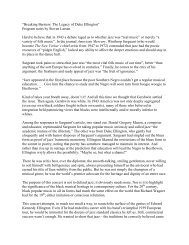JOHN ADAMS The Chairman Dances (Foxtrot for Orchestra) John ...
JOHN ADAMS The Chairman Dances (Foxtrot for Orchestra) John ...
JOHN ADAMS The Chairman Dances (Foxtrot for Orchestra) John ...
Create successful ePaper yourself
Turn your PDF publications into a flip-book with our unique Google optimized e-Paper software.
that appears in the opera in a more tender and wistful mood. Listeners who<br />
hear <strong>The</strong> <strong>Chairman</strong> <strong>Dances</strong> be<strong>for</strong>e seeing the opera will be struck by its<br />
evocative power in that context. And those who simply hear the concert work<br />
on its own can enjoy a modern composer’s idea of a Hollywood foxtrot from<br />
sixty years ago.<br />
PAUL HINDEMITH<br />
Symphonic Metamorphoses on themes<br />
of Carl Maria von Weber<br />
Paul Hindemith was born in Hanau, near Frankfurt, Germany,<br />
on November 16, 1895, and died in Frankfurt on December<br />
28, 1963. He composed his Sinfonische Metamorphosen nach<br />
<strong>The</strong>men von Carl Maria von Weber in New Haven, Connecticut,<br />
in 1943. Artur Rodzinski led the New York Philharmonic-<br />
Symphony Society in the first per<strong>for</strong>mance on January 20,<br />
1944. <strong>The</strong> score calls <strong>for</strong> two flutes and piccolo, two oboes and English horn,<br />
two clarinets and bass clarinet, two bassoons and contrabassoon, four horns,<br />
two trumpets, three trombones and tuba, percussion (bass drum, small drum,<br />
snare drum, tom-tom, tambourine, triangle, small gong, cymbals, small<br />
cymbals, chimes, and glockenspiel), and strings. Duration is about 21 minutes.<br />
In the early 1940s, Paul Hindemith came to the United States <strong>for</strong> what was<br />
ostensibly a visit, though it became a residence of many years. He was a well<br />
known composer, and he happily found a number of per<strong>for</strong>mances <strong>for</strong> his<br />
music, though he was also <strong>for</strong>ced to teach students he felt were a waste of his<br />
time and energies. In order to continue his own creative work, he brought with<br />
him from Europe several plans <strong>for</strong> new pieces, one of which was a ballet based<br />
on themes by Carl Maria von Weber, to be choreographed by Leonid Massine.<br />
Though Massine had made a successful dance piece about St. Francis out<br />
of Hindemith’s Nobilissima Visione in England not long be<strong>for</strong>e, the two men<br />
had sharply contrasting artistic goals. <strong>The</strong> new score made no progress, and<br />
Hindemith dropped the project. But, as things turned out, the ef<strong>for</strong>t he had<br />
already put into the piece was not wasted. In 1943, the New York Philharmonic<br />
invited the distinguished <strong>for</strong>eign composer, now living in the United States, to<br />
submit a new work <strong>for</strong> per<strong>for</strong>mance. Hindemith turned back<br />
to the Weber excerpts and quickly produced one of his most popular<br />
orchestral works.<br />
During his all-too-brief <strong>for</strong>ty years, Carl Maria von Weber (1786 1826)<br />
almost single handedly created German romantic opera with Der Freischütz,<br />
Euryanthe, and Oberon. His works contained characters that embodied honor<br />
and nobility, love and sacrifice, thus representing the highest ideals of a<br />
humane German culture. In 1943, at a time when German culture seemed to<br />
have been overwhelmed by barbarism, Hindemith, then teaching at Yale, paid<br />
homage to his great predecessor among German composers by turning some<br />
little four-hand piano pieces by Weber into a brilliantly elaborated, playful<br />
symphonic score.<br />
Hindemith was an active per<strong>for</strong>mer, a distinguished violist, who wanted to write<br />
music that would “sound” in per<strong>for</strong>mance, yet that also grew out of a carefully<br />
balanced interrelationship between melody, harmony, and counterpoint. After<br />
sowing his artistic wild oats in a series of youthful works that pleased advanced<br />
musicians but outraged conservative ones (including the Nazis, who banned<br />
his music), Hindemith settled into a maturity lasting some three decades.<br />
His compositional style offered a remarkable consistency in its neo-classical<br />
approach, its careful dissonance treatment, and an increasing sensitivity to<br />
orchestral color.<br />
For the Symphonic Metamorphoses, Hindemith chose themes mostly from<br />
Weber’s four-hand piano music, with the exception of the second movement,



